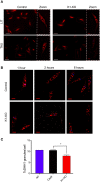GCN2-Like Kinase Modulates Stress Granule Formation During Nutritional Stress in Trypanosoma cruzi
- PMID: 32373547
- PMCID: PMC7176912
- DOI: 10.3389/fcimb.2020.00149
GCN2-Like Kinase Modulates Stress Granule Formation During Nutritional Stress in Trypanosoma cruzi
Abstract
The integrated stress response in eukaryotic cells is an orchestrated pathway that leads to eukaryotic Initiation Factor 2 alpha subunit (eIF2α) phosphorylation at ser51 and ultimately activates pathways to mitigate cellular damages. Three putative kinases (Tck1, Tck2, and Tck3) are found in the Trypanosoma cruzi genome, the flagellated parasite that causes Chagas disease. These kinases present similarities to other eukaryotic eIF2α kinases, exhibiting a typical insertion loop in the kinase domain of the protein. We found that this insertion loop is conserved among kinase 1 of several T. cruzi strains but differs among various Kinetoplastidae species, suggesting unique roles. Kinase 1 is orthologous of GCN2 of several eukaryotes, which have been implicated in the eIF2α ser51 phosphorylation in situations that mainly affects the nutrients levels. Therefore, we further investigated the responses to nutritional stress of T. cruzi devoid of TcK1 generated by CRISPR/Cas9 gene replacement. In nutrient-rich conditions, replicative T. cruzi epimastigotes depleted of TcK1 proliferate as wild type cells but showed increased levels of polysomes relative to monosomes. Upon nutritional deprivation, the polysomes decreased more than in TcK1 depleted line. However, eIF2α is still phosphorylated in TcK1 depleted line, as in wild type parasites. eIF2α phosphorylation increased at longer incubations times, but KO parasites showed less accumulation of ribonucleoprotein granules containing ATP-dependent RNA helicase involved in mRNA turnover (DHH1) and Poly-A binding protein (PABP1). Additionally, the formation of metacyclic-trypomastigotes is increased in the absence of Tck1 compared to controls. These metacyclics, as well as tissue culture trypomastigotes derived from the TcK1 knockout line, were less infective to mammalian host cells, although replicated faster inside mammalian cells. These results indicate that GCN2-like kinase in T. cruzi affects stress granule formation, independently of eIF2α phosphorylation upon nutrient deprivation. It also modulates the fate of the parasites during differentiation, invasion, and intracellular proliferation.
Keywords: CRISPR/Cas9; GCN2; TcK1; Trypanosoma cruzi; eIF2α; phosphorylation; stress-granules.
Copyright © 2020 Malvezzi, Aricó, Souza-Melo, dos Santos, Bittencourt-Cunha, Holetz and Schenkman.
Figures







Similar articles
-
Identification of inhibitors for the transmembrane Trypanosoma cruzi eIF2α kinase relevant for parasite proliferation.J Biol Chem. 2023 Jul;299(7):104857. doi: 10.1016/j.jbc.2023.104857. Epub 2023 May 23. J Biol Chem. 2023. PMID: 37230387 Free PMC article.
-
Protein synthesis attenuation by phosphorylation of eIF2α is required for the differentiation of Trypanosoma cruzi into infective forms.PLoS One. 2011;6(11):e27904. doi: 10.1371/journal.pone.0027904. Epub 2011 Nov 16. PLoS One. 2011. PMID: 22114724 Free PMC article.
-
EIF2α phosphorylation is regulated in intracellular amastigotes for the generation of infective Trypanosoma cruzi trypomastigote forms.Cell Microbiol. 2020 Nov;22(11):e13243. doi: 10.1111/cmi.13243. Epub 2020 Jul 28. Cell Microbiol. 2020. PMID: 32597009
-
Mammalian cell invasion and intracellular trafficking by Trypanosoma cruzi infective forms.An Acad Bras Cienc. 2005 Mar;77(1):77-94. doi: 10.1590/s0001-37652005000100006. Epub 2005 Feb 2. An Acad Bras Cienc. 2005. PMID: 15692679 Review.
-
Trypanosoma cruzi: parasite and host cell signaling during the invasion process.Subcell Biochem. 2008;47:82-91. doi: 10.1007/978-0-387-78267-6_6. Subcell Biochem. 2008. PMID: 18512343 Review.
Cited by
-
CRISPR Genome Editing and the Study of Chagas Disease.Adv Exp Med Biol. 2023;1429:111-125. doi: 10.1007/978-3-031-33325-5_7. Adv Exp Med Biol. 2023. PMID: 37486519
-
Differentiation granules, a dynamic regulator of T. brucei development.Nat Commun. 2024 Apr 6;15(1):2972. doi: 10.1038/s41467-024-47309-1. Nat Commun. 2024. PMID: 38582942 Free PMC article.
-
Dual and Opposite Roles of Reactive Oxygen Species (ROS) in Chagas Disease: Beneficial on the Pathogen and Harmful on the Host.Oxid Med Cell Longev. 2020 Dec 10;2020:8867701. doi: 10.1155/2020/8867701. eCollection 2020. Oxid Med Cell Longev. 2020. PMID: 33376582 Free PMC article. Review.
-
Strategies in the delivery of Cas9 ribonucleoprotein for CRISPR/Cas9 genome editing.Theranostics. 2021 Jan 1;11(2):614-648. doi: 10.7150/thno.47007. eCollection 2021. Theranostics. 2021. PMID: 33391496 Free PMC article. Review.
-
Attenuation of Activated eIF2α Signaling by ISRIB Treatment After Spinal Cord Injury Improves Locomotor Function.J Mol Neurosci. 2022 Mar;72(3):585-597. doi: 10.1007/s12031-021-01920-9. Epub 2021 Oct 13. J Mol Neurosci. 2022. PMID: 34647267 Free PMC article.
References
Publication types
MeSH terms
Substances
LinkOut - more resources
Full Text Sources
Medical
Research Materials

